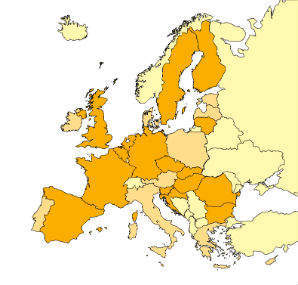A revision to a European nuclear safety directive that would mean power plant reviews every six years now only requires member state approval to become law.

The text of the post-Fukushima revision to the 2009 Nuclear Safety Directive, first proposed in June 2013, was adopted (in a non-binding resolution) by the European Parliament on 2 April. On 11 June, the Permanent Representatives Committee of the Council of the European Union (COREPER) acknowledged the agreement reached by Member States on the Commission’s proposal to amend the 2009 Nuclear Safety Directive. It now must be formally adopted by the European Council, which consists of heads of state of European Union member states. Once approved, states would have 18 months to implement it.
According to a June 2013 press release and web materials from the European Commission , the new directive establishes:
- Safety objective: Member States shall ensure that – in case of accidents – the release of radioactivity in the environment is practically eliminated.
- EU-wide, legally binding reviews every six years: Member States will jointly agree on the specific topic (s) and the common methodology of the reviews that multinational teams will carry out. First, national assessments will be prepared, and these will be submitted for a peer review. The results of the peer review will then be translated into concrete technical recommendations. Member States are also responsible for implementing the recommendations. In case, there is a delay or recommendations are not implemented, the European Commission can organize a verification mission to the Member State. In addition, in case of an accident and major safety problems, the Member State has to organise a peer review of the installation within six months. Results would be made public by national regulators.
- National reviews: Every nuclear power plant undergoes a periodic safety review at least once every 10 years and a specific review in case of a possible life time extention;
- New Power Plants: All new nuclear power plants are designed in a way which ensures that if a reactor core is damaged, this has no consequences outside the plant;
- On-site emergency preparedness and response: Every Nuclear Power Plant needs to have an emergency response centres which is protected against radioactivity and earthquakes or flooding and implementing strict accident management guidelines;
- As to transparency, national regulatory authorities and plant operators will have to develop a strategy, which will define how public is informed in the event of an accident, but also in times of normal operation of the plant. This strategy will have to be published. In addition, citizens will have the opportunity to participate in the decision-making process when the licensing of a new nuclear power plant is being chosen.
- Specific safety reviews would be required for older nuclear power plants for which a lifetime extension is considered
- Finally, the directive ensures that national regulatory authorities are independent in their decision-making and that political, economic or societal interests cannot override safety objectives. National regulatory authorities must be allocated sufficient funds and expert staff to allow their effective operation.
The full text of the rule approved by the European Parliament is available on http://www.europarl.europa.eu/sides/getDoc.do?type=TA&reference=P7-TA-2014-0274&format=XML&language=EN. There is more information about the revised directive on http://ec.europa.eu/energy/nuclear/safety/safety_en.htm.
There are 132 reactors operating in 14 member states, four under construction in three countries, and 16 planned in nine countries.
European Energy Commissioner Günther Oettinger said: "We need to put all our efforts into making sure that the highest safety standards are followed in every single nuclear power plant across the EU."
The chairman of ENSREG, the group of scientific experts established under the Article 31 of Euratom Treaty, Gerald Hennenhöfer, acknowledged the progress of the rulemaking in a summary of a 27 May meeting. He said: "In view of the progress on finalising the text of the revised Nuclear Safety Directive, ENSREG recognised the need for further work in developing a common approach in areas such as topical peer reviews."
Map of nuclear Europe: countries with operating nuclear power plants are orange; those outside of the EU are light yellow; those within the UE but without nuclear power are in pale orange. From ENSREG.eu
